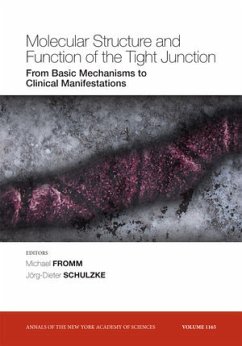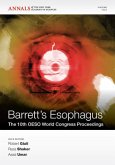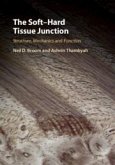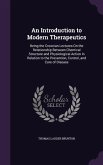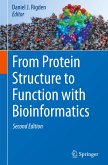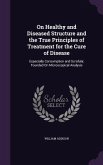Molecular Structure and Function of the Tight Junction
From Basic Mechanisms to Clinical Manifestations, Volume 1165
Herausgeber: Fromm, Michael; Schulzke, Jörg-Dieter
Schade – dieser Artikel ist leider ausverkauft. Sobald wir wissen, ob und wann der Artikel wieder verfügbar ist, informieren wir Sie an dieser Stelle.
Molecular Structure and Function of the Tight Junction
From Basic Mechanisms to Clinical Manifestations, Volume 1165
Herausgeber: Fromm, Michael; Schulzke, Jörg-Dieter
- Broschiertes Buch
- Merkliste
- Auf die Merkliste
- Bewerten Bewerten
- Teilen
- Produkt teilen
- Produkterinnerung
- Produkterinnerung
Aim of this volume is to clarify the relationship between molecular structure and function of tight junction proteins, as well as their regulation and their role in diseases. Current research may form a basis for future diagnostic and therapeutic approaches to diseases which seem to have not much in common but are characterized by defects of organ barriers, like Crohn's disease, renal hypertension, inner ear deafness, and cancerous diseases. Topics include the functions of distinct tight junction proteins as barrier or channel formers for solutes and water, characteristics of the tight…mehr
Andere Kunden interessierten sich auch für
![Gastroenterology, an Issue of Primary Care Clinics in Office Practice Gastroenterology, an Issue of Primary Care Clinics in Office Practice]() James WingerGastroenterology, an Issue of Primary Care Clinics in Office Practice66,99 €
James WingerGastroenterology, an Issue of Primary Care Clinics in Office Practice66,99 €![Barrett's Esophagus Barrett's Esophagus]() Barrett's Esophagus132,99 €
Barrett's Esophagus132,99 €![The Soft-Hard Tissue Junction The Soft-Hard Tissue Junction]() Neil D BroomThe Soft-Hard Tissue Junction130,99 €
Neil D BroomThe Soft-Hard Tissue Junction130,99 €![An Introduction to Modern Therapeutics: Being the Croonian Lectures On the Relationship Between Chemical Structure and Physiological Action in Relatio An Introduction to Modern Therapeutics: Being the Croonian Lectures On the Relationship Between Chemical Structure and Physiological Action in Relatio]() Thomas Lauder BruntonAn Introduction to Modern Therapeutics: Being the Croonian Lectures On the Relationship Between Chemical Structure and Physiological Action in Relatio32,99 €
Thomas Lauder BruntonAn Introduction to Modern Therapeutics: Being the Croonian Lectures On the Relationship Between Chemical Structure and Physiological Action in Relatio32,99 €![Medical Staffing Structure in the Hospital Service Medical Staffing Structure in the Hospital Service]() H. PlattMedical Staffing Structure in the Hospital Service28,99 €
H. PlattMedical Staffing Structure in the Hospital Service28,99 €![From Protein Structure to Function with Bioinformatics From Protein Structure to Function with Bioinformatics]() From Protein Structure to Function with Bioinformatics223,99 €
From Protein Structure to Function with Bioinformatics223,99 €![On Healthy and Diseased Structure and the True Principles of Treatment for the Cure of Disease On Healthy and Diseased Structure and the True Principles of Treatment for the Cure of Disease]() William AddisonOn Healthy and Diseased Structure and the True Principles of Treatment for the Cure of Disease38,99 €
William AddisonOn Healthy and Diseased Structure and the True Principles of Treatment for the Cure of Disease38,99 €-
-
-
Aim of this volume is to clarify the relationship between molecular structure and function of tight junction proteins, as well as their regulation and their role in diseases. Current research may form a basis for future diagnostic and therapeutic approaches to diseases which seem to have not much in common but are characterized by defects of organ barriers, like Crohn's disease, renal hypertension, inner ear deafness, and cancerous diseases. Topics include the functions of distinct tight junction proteins as barrier or channel formers for solutes and water, characteristics of the tight junction in inflammatory bowel diseases, posttranslational modifications of tight junction proteins, the relation between renal tight junction proteins and blood pressure control, and the molecular structure of claudin-claudin interactions NOTE: Annals volumes are available for sale as individual books or as a journal. For information on institutional journal subscriptions, please visit www.blackwellpublishing.com/nyas. ACADEMY MEMBERS: Please contact the New York Academy of Sciences directly to place your order (www.nyas.org). Members of the New York Academy of Science receive full-text access to the Annals online and discounts on print volumes. Please visit http://www.nyas.org/MemberCenter/Join.aspx for more information about becoming a member.
Produktdetails
- Produktdetails
- Verlag: John Wiley & Sons / Wiley
- Seitenzahl: 300
- Erscheinungstermin: 22. Juni 2009
- Englisch
- Abmessung: 249mm x 175mm x 15mm
- Gewicht: 726g
- ISBN-13: 9781573317498
- ISBN-10: 1573317497
- Artikelnr.: 27564991
- Herstellerkennzeichnung
- Libri GmbH
- Europaallee 1
- 36244 Bad Hersfeld
- gpsr@libri.de
- Verlag: John Wiley & Sons / Wiley
- Seitenzahl: 300
- Erscheinungstermin: 22. Juni 2009
- Englisch
- Abmessung: 249mm x 175mm x 15mm
- Gewicht: 726g
- ISBN-13: 9781573317498
- ISBN-10: 1573317497
- Artikelnr.: 27564991
- Herstellerkennzeichnung
- Libri GmbH
- Europaallee 1
- 36244 Bad Hersfeld
- gpsr@libri.de
Michael Fromm is the editor of Molecular Structure and Function of the Tight Junction: From Basic Mechanisms to Clinical Manifestations, Volume 1165, published by Wiley. Jörg-Dieter Schulzke is the editor of Molecular Structure and Function of the Tight Junction: From Basic Mechanisms to Clinical Manifestations, Volume 1165, published by Wiley.
Introduction.
Tight junctions: Molecular structure meets function (Jörg-Dieter Schulzke
and Michael Fromm).
The Life and Work of Shoichiro Tsukita (James Melvin Anderson).
Part I. Molecular Structure of the Tight Junction
1. Mechanisms of outside-in signaling at the tight junction by junctional
adhesionmolecule A Eric A. Severson and Charles A. Parkos).
2. The oligomerization of the coiled coil-domain of occluddin is
redox-sensitive (Juliane K. Walter, Christine Rueckert, Martin Voss,
Sebastian L. Müller, Jörg Piontek, Klaus Gast and Ingolf E. Blasig).
3. Vertebrate animal models unravel physiological roles for Zonula
occludens tight junction adaptor proteins (Walter Hunziker, Tania K.
Kiener, and Jianliang Xu).
4. Structure and function of extracellular claudin domains (Gerd Krause,
Lars Winkler, Christian Piehl, Ingolf Blasig, Jörg Piontek, Sebastian L.
Müller).
5. Roles of ZO-1 and ZO-2 in establishment of the belt-like adherens and
tight junctions with paracellular permselective barrier function (Sachiko
Tsukita, Tatsuya Katsuno, Yuji Yamazaki, Kazuaki Umeda, Atsushi Tamura, and
Shoichiro Tsukita).
6. Molecular basis for cation selectivity in claudin-2-based pores (Alan S.
L. Yu).
7. The role claudin-based tight junctions in morphogenesis (Mikio Furuse).
8. Occludin phosphorylation in regulation of epithelial tight junctions (
Radhakrishna Rao).
9. Differential phosphorylation of occludin and tricellulin by CK2 and CK1
(Max J. Dörfel, Julie K. Westphal and Otmar Huber).
Part II. Regulation of the Tight Junction and Barrier Function.
10. High resolution analysis of barrier function (Michael Fromm, Susanne M.
Krug, Sebastian Zeissig, Jan F. Richter, Rita Rosenthal, Jörg-Dieter
Schulzke and Dorothee Günzel).
11. Claudin-2-dependent changes in noncharged solute flux are mediated by
the extracellular domains and require attachment to the PDZ-scaffold (
Christina M. Van Itallie, Jennifer Holmes, Arlene Bridges and James Melvin
Anderson).
12. The tight junction protein cingulin regulates gene expression and RhoA
signalling (Sandra Citi, Serge Paschoud, Pamela Pulimeno, Francesco
Timolati, Fabrizio De Robertis, Lionel Jond and Laurent Guillemot).
13. Modification of tight junction structure and permeability by
nutritional means (James M. Mullin, Sonja M. Skrovanekc, and Mary Carmen
Valenzanoa).
14. ZO-1 and ZO-2 are Cytosolic Scaffolds that Regulate the Assembly of
Cellular Junctions (Alan S. Fanning and James M. Anderson).
15. The tight junction protein ZO-2 blocks cell cycle progression and
inhibits cyclin D1 expression (Lorenza Gonzalez-Mariscal, Rocio Tapia,
Miriam Huerta and Esther Lopez-Bayghen).
16. Analysis of claudin genes in pediatric patients with Bartter's syndrome
(Yan-Hua Chen, Jen-Jar Lin, Beverly G. Jeansonne,Rodney Tatum, and Qun Lua
).
17. Mechanisms of epithelial cell shedding in the mammalian intestine and
maintenance of barrier function (Alastair J.M. Watson, Carrie A Duckworth,
Yanfang Guan and Marshall H. Montrose).
18. Cysteine mutagenesis to study the structure of claudin-2 paracellular (
Susanne Angelow and Alan S. L. Yu).
19. Insights into driving forces and paracellular permeability from
claudin-16 knockdown mouse (Qixian Shan, Nina Himmerkus, Jianghui Hou,
Daniel A. Goodenough and Markus Bleich).
20. Claudin function in the thick ascending limb of Henle's loop (Dorothee
Günzel, Lea Haisch, Sandra Pfaffenbach, Susanne M. Krug, Susanne Milatz,
Salah Amasheh, Walter Hunziker and Dominik Müller).
21. Cadherin mediated regulation of tight junctions in stratifying
epithelia (Christian Michels, Saeed Yadranji Aghdam and Carien M. Niessen
).
Part III. Immune System, Microbes, and the Gastrointestinal Barrier.
22. Tight junctions and enteropathogenic E. coli (Andrew W. Weflen, Neal M.
Alto, and Gail A. Hecht).
23. Modulation of intestinal barrier properties by probiotics - role in
reversing colitis (Silvia C. Resta-Lenert and Kim E. Barrett).
24. Effect of probiotics on intestinal barrier function (Rudolf Mennigen
and Matthias Bruewer).
25. Probiotic therapy in radiation induced intestinal injury and repair (
Matthew A Ciorba and William F. Stenson).
26. Tight junctions, intestinal permeability and autoimmunity. The Celiac
Disease and Type 1 Diabetes Paradigms (Jeroen Visser, Jan Rozing, Anna
Sapone, Karen Lammers, and Alessio Fasano).
27. Corticotropin-releasing hormone and mast cells in the regulation of
mucosal barrier function in the human colon (Conny Wallon and Johan D.
Söderholm).
Part IV. Transport and Epithelial Barrier.
28. Tight junction proteins as channel formers and barrier builders:
claudin-2, -5, and -8 (Salah Amasheh, Susanne Milatz, Susanne M. Krug,
Alexander G. Markov, Dorothee Günzel, Maren Amasheh and Michael Fromm).
29. Dynamic regulation of epithelial cell fate and barrier function by
intercellular Junctions (Stefan Koch and Asma Nusrat).
30. Control of the blood brain barrier by glucocorticoids and the cells of
the neurovascular unit (Susanne Kröll, Jehad El-Gindi, Gokulan
Thanabalasundaram, Patcharee Panpumthong, Sebastian Schrot, Christoph
Hartmann and Hans-Joachim Galla).
31. Regulation of intestinal electroneutral sodium absorption and the brush
border Na+/H+ exchanger (NHE3) by intracellular calcium (Nicholas C.
Zachos, Olga Kovbasnjuk and Mark Donowitz).
32. The role of the NHERF family of PDZ scaffolding proteins in the
regulation of salt and water transport: lessons learned from knockout mice
(Ursula Seidler, Anurag Kumar Singh, Ayhan Cinar, Mingmin Chen, Jutta
Hillesheim, Boris Hogema and Brigitte Riederer).
33. Regulation of the intestinal anion exchanger DRA (down regulated in
adenoma) (Georg Lamprecht, Vera Gaco, Jerrold R. Turner, Dorgam Natour and
Michael Gregor).
34. Barrier effects of nutritional factors (Maren Amasheh, Susanne Andres,
Salah Amasheh, Michael Fromm and Jörg-Dieter Schulzke).
35. Pathways of gliadin transport in celiac disease (Martine Heyman and
Sandrine Menard).
36. A new insight into pathophysiological mechanisms of zinc in diarrhea (
Kazi Mirajul Hoque, Rafiquel Sarker, Sandra E. Guggino and Chung-Ming Tse
).
Part V. Inflammation and Gastrointestinal Function.
37. Mechanisms of diarrhea in inflammatory bowel diseases (Henry J. Binder
).
38. Epithelial tight junctions in intestinal inflammation (Joerg D.
Schulzke, Svenja Ploeger, Maren Amasheh, Anja Fromm, Sebastian Zeissig,
Hanno Troeger, Jan Richter, Christian Bojarski, Michael Schumann and
Michael Fromm).
39. Mechanisms of tight junction dysregulation in the SAMP1/YitFc model of
Crohn's disease-like ileitis (Brian K. Reuter and Theresa T. Pizarro).
40. The role of JAM-A in Inflammatory bowel disease: unrevealing the ties
that bind (Stefania Vetrano and Silvio Danese).
41. No static at all: A new perspective on molecular architecture of the
tight junction (W. Vallen Graham, Amanda M. Marchiando, Le Shen and Jerrold
R. Turner).
42. Lymphoepithelial Interactions: A new paradigm (Stephanie Dahan,
Franziska Roth-Walter, Andrea P. Martin, Paul Arnaboldi and Lloyd Mayer).
43. Metabolic stress evokes decreases in epithelial barrier function:
mechanistic insights from in vitro and in vivo model systems (Kimberley
Lewis and Derek M. McKay).
44. Enteral versus parenteral nutrition: Effect on intestinal barrier
function (Hua Yang, Yongjia Feng, Xiaoyi Sun and Daniel H. Teitelbaum).
Tight junctions: Molecular structure meets function (Jörg-Dieter Schulzke
and Michael Fromm).
The Life and Work of Shoichiro Tsukita (James Melvin Anderson).
Part I. Molecular Structure of the Tight Junction
1. Mechanisms of outside-in signaling at the tight junction by junctional
adhesionmolecule A Eric A. Severson and Charles A. Parkos).
2. The oligomerization of the coiled coil-domain of occluddin is
redox-sensitive (Juliane K. Walter, Christine Rueckert, Martin Voss,
Sebastian L. Müller, Jörg Piontek, Klaus Gast and Ingolf E. Blasig).
3. Vertebrate animal models unravel physiological roles for Zonula
occludens tight junction adaptor proteins (Walter Hunziker, Tania K.
Kiener, and Jianliang Xu).
4. Structure and function of extracellular claudin domains (Gerd Krause,
Lars Winkler, Christian Piehl, Ingolf Blasig, Jörg Piontek, Sebastian L.
Müller).
5. Roles of ZO-1 and ZO-2 in establishment of the belt-like adherens and
tight junctions with paracellular permselective barrier function (Sachiko
Tsukita, Tatsuya Katsuno, Yuji Yamazaki, Kazuaki Umeda, Atsushi Tamura, and
Shoichiro Tsukita).
6. Molecular basis for cation selectivity in claudin-2-based pores (Alan S.
L. Yu).
7. The role claudin-based tight junctions in morphogenesis (Mikio Furuse).
8. Occludin phosphorylation in regulation of epithelial tight junctions (
Radhakrishna Rao).
9. Differential phosphorylation of occludin and tricellulin by CK2 and CK1
(Max J. Dörfel, Julie K. Westphal and Otmar Huber).
Part II. Regulation of the Tight Junction and Barrier Function.
10. High resolution analysis of barrier function (Michael Fromm, Susanne M.
Krug, Sebastian Zeissig, Jan F. Richter, Rita Rosenthal, Jörg-Dieter
Schulzke and Dorothee Günzel).
11. Claudin-2-dependent changes in noncharged solute flux are mediated by
the extracellular domains and require attachment to the PDZ-scaffold (
Christina M. Van Itallie, Jennifer Holmes, Arlene Bridges and James Melvin
Anderson).
12. The tight junction protein cingulin regulates gene expression and RhoA
signalling (Sandra Citi, Serge Paschoud, Pamela Pulimeno, Francesco
Timolati, Fabrizio De Robertis, Lionel Jond and Laurent Guillemot).
13. Modification of tight junction structure and permeability by
nutritional means (James M. Mullin, Sonja M. Skrovanekc, and Mary Carmen
Valenzanoa).
14. ZO-1 and ZO-2 are Cytosolic Scaffolds that Regulate the Assembly of
Cellular Junctions (Alan S. Fanning and James M. Anderson).
15. The tight junction protein ZO-2 blocks cell cycle progression and
inhibits cyclin D1 expression (Lorenza Gonzalez-Mariscal, Rocio Tapia,
Miriam Huerta and Esther Lopez-Bayghen).
16. Analysis of claudin genes in pediatric patients with Bartter's syndrome
(Yan-Hua Chen, Jen-Jar Lin, Beverly G. Jeansonne,Rodney Tatum, and Qun Lua
).
17. Mechanisms of epithelial cell shedding in the mammalian intestine and
maintenance of barrier function (Alastair J.M. Watson, Carrie A Duckworth,
Yanfang Guan and Marshall H. Montrose).
18. Cysteine mutagenesis to study the structure of claudin-2 paracellular (
Susanne Angelow and Alan S. L. Yu).
19. Insights into driving forces and paracellular permeability from
claudin-16 knockdown mouse (Qixian Shan, Nina Himmerkus, Jianghui Hou,
Daniel A. Goodenough and Markus Bleich).
20. Claudin function in the thick ascending limb of Henle's loop (Dorothee
Günzel, Lea Haisch, Sandra Pfaffenbach, Susanne M. Krug, Susanne Milatz,
Salah Amasheh, Walter Hunziker and Dominik Müller).
21. Cadherin mediated regulation of tight junctions in stratifying
epithelia (Christian Michels, Saeed Yadranji Aghdam and Carien M. Niessen
).
Part III. Immune System, Microbes, and the Gastrointestinal Barrier.
22. Tight junctions and enteropathogenic E. coli (Andrew W. Weflen, Neal M.
Alto, and Gail A. Hecht).
23. Modulation of intestinal barrier properties by probiotics - role in
reversing colitis (Silvia C. Resta-Lenert and Kim E. Barrett).
24. Effect of probiotics on intestinal barrier function (Rudolf Mennigen
and Matthias Bruewer).
25. Probiotic therapy in radiation induced intestinal injury and repair (
Matthew A Ciorba and William F. Stenson).
26. Tight junctions, intestinal permeability and autoimmunity. The Celiac
Disease and Type 1 Diabetes Paradigms (Jeroen Visser, Jan Rozing, Anna
Sapone, Karen Lammers, and Alessio Fasano).
27. Corticotropin-releasing hormone and mast cells in the regulation of
mucosal barrier function in the human colon (Conny Wallon and Johan D.
Söderholm).
Part IV. Transport and Epithelial Barrier.
28. Tight junction proteins as channel formers and barrier builders:
claudin-2, -5, and -8 (Salah Amasheh, Susanne Milatz, Susanne M. Krug,
Alexander G. Markov, Dorothee Günzel, Maren Amasheh and Michael Fromm).
29. Dynamic regulation of epithelial cell fate and barrier function by
intercellular Junctions (Stefan Koch and Asma Nusrat).
30. Control of the blood brain barrier by glucocorticoids and the cells of
the neurovascular unit (Susanne Kröll, Jehad El-Gindi, Gokulan
Thanabalasundaram, Patcharee Panpumthong, Sebastian Schrot, Christoph
Hartmann and Hans-Joachim Galla).
31. Regulation of intestinal electroneutral sodium absorption and the brush
border Na+/H+ exchanger (NHE3) by intracellular calcium (Nicholas C.
Zachos, Olga Kovbasnjuk and Mark Donowitz).
32. The role of the NHERF family of PDZ scaffolding proteins in the
regulation of salt and water transport: lessons learned from knockout mice
(Ursula Seidler, Anurag Kumar Singh, Ayhan Cinar, Mingmin Chen, Jutta
Hillesheim, Boris Hogema and Brigitte Riederer).
33. Regulation of the intestinal anion exchanger DRA (down regulated in
adenoma) (Georg Lamprecht, Vera Gaco, Jerrold R. Turner, Dorgam Natour and
Michael Gregor).
34. Barrier effects of nutritional factors (Maren Amasheh, Susanne Andres,
Salah Amasheh, Michael Fromm and Jörg-Dieter Schulzke).
35. Pathways of gliadin transport in celiac disease (Martine Heyman and
Sandrine Menard).
36. A new insight into pathophysiological mechanisms of zinc in diarrhea (
Kazi Mirajul Hoque, Rafiquel Sarker, Sandra E. Guggino and Chung-Ming Tse
).
Part V. Inflammation and Gastrointestinal Function.
37. Mechanisms of diarrhea in inflammatory bowel diseases (Henry J. Binder
).
38. Epithelial tight junctions in intestinal inflammation (Joerg D.
Schulzke, Svenja Ploeger, Maren Amasheh, Anja Fromm, Sebastian Zeissig,
Hanno Troeger, Jan Richter, Christian Bojarski, Michael Schumann and
Michael Fromm).
39. Mechanisms of tight junction dysregulation in the SAMP1/YitFc model of
Crohn's disease-like ileitis (Brian K. Reuter and Theresa T. Pizarro).
40. The role of JAM-A in Inflammatory bowel disease: unrevealing the ties
that bind (Stefania Vetrano and Silvio Danese).
41. No static at all: A new perspective on molecular architecture of the
tight junction (W. Vallen Graham, Amanda M. Marchiando, Le Shen and Jerrold
R. Turner).
42. Lymphoepithelial Interactions: A new paradigm (Stephanie Dahan,
Franziska Roth-Walter, Andrea P. Martin, Paul Arnaboldi and Lloyd Mayer).
43. Metabolic stress evokes decreases in epithelial barrier function:
mechanistic insights from in vitro and in vivo model systems (Kimberley
Lewis and Derek M. McKay).
44. Enteral versus parenteral nutrition: Effect on intestinal barrier
function (Hua Yang, Yongjia Feng, Xiaoyi Sun and Daniel H. Teitelbaum).
Introduction.
Tight junctions: Molecular structure meets function (Jörg-Dieter Schulzke
and Michael Fromm).
The Life and Work of Shoichiro Tsukita (James Melvin Anderson).
Part I. Molecular Structure of the Tight Junction
1. Mechanisms of outside-in signaling at the tight junction by junctional
adhesionmolecule A Eric A. Severson and Charles A. Parkos).
2. The oligomerization of the coiled coil-domain of occluddin is
redox-sensitive (Juliane K. Walter, Christine Rueckert, Martin Voss,
Sebastian L. Müller, Jörg Piontek, Klaus Gast and Ingolf E. Blasig).
3. Vertebrate animal models unravel physiological roles for Zonula
occludens tight junction adaptor proteins (Walter Hunziker, Tania K.
Kiener, and Jianliang Xu).
4. Structure and function of extracellular claudin domains (Gerd Krause,
Lars Winkler, Christian Piehl, Ingolf Blasig, Jörg Piontek, Sebastian L.
Müller).
5. Roles of ZO-1 and ZO-2 in establishment of the belt-like adherens and
tight junctions with paracellular permselective barrier function (Sachiko
Tsukita, Tatsuya Katsuno, Yuji Yamazaki, Kazuaki Umeda, Atsushi Tamura, and
Shoichiro Tsukita).
6. Molecular basis for cation selectivity in claudin-2-based pores (Alan S.
L. Yu).
7. The role claudin-based tight junctions in morphogenesis (Mikio Furuse).
8. Occludin phosphorylation in regulation of epithelial tight junctions (
Radhakrishna Rao).
9. Differential phosphorylation of occludin and tricellulin by CK2 and CK1
(Max J. Dörfel, Julie K. Westphal and Otmar Huber).
Part II. Regulation of the Tight Junction and Barrier Function.
10. High resolution analysis of barrier function (Michael Fromm, Susanne M.
Krug, Sebastian Zeissig, Jan F. Richter, Rita Rosenthal, Jörg-Dieter
Schulzke and Dorothee Günzel).
11. Claudin-2-dependent changes in noncharged solute flux are mediated by
the extracellular domains and require attachment to the PDZ-scaffold (
Christina M. Van Itallie, Jennifer Holmes, Arlene Bridges and James Melvin
Anderson).
12. The tight junction protein cingulin regulates gene expression and RhoA
signalling (Sandra Citi, Serge Paschoud, Pamela Pulimeno, Francesco
Timolati, Fabrizio De Robertis, Lionel Jond and Laurent Guillemot).
13. Modification of tight junction structure and permeability by
nutritional means (James M. Mullin, Sonja M. Skrovanekc, and Mary Carmen
Valenzanoa).
14. ZO-1 and ZO-2 are Cytosolic Scaffolds that Regulate the Assembly of
Cellular Junctions (Alan S. Fanning and James M. Anderson).
15. The tight junction protein ZO-2 blocks cell cycle progression and
inhibits cyclin D1 expression (Lorenza Gonzalez-Mariscal, Rocio Tapia,
Miriam Huerta and Esther Lopez-Bayghen).
16. Analysis of claudin genes in pediatric patients with Bartter's syndrome
(Yan-Hua Chen, Jen-Jar Lin, Beverly G. Jeansonne,Rodney Tatum, and Qun Lua
).
17. Mechanisms of epithelial cell shedding in the mammalian intestine and
maintenance of barrier function (Alastair J.M. Watson, Carrie A Duckworth,
Yanfang Guan and Marshall H. Montrose).
18. Cysteine mutagenesis to study the structure of claudin-2 paracellular (
Susanne Angelow and Alan S. L. Yu).
19. Insights into driving forces and paracellular permeability from
claudin-16 knockdown mouse (Qixian Shan, Nina Himmerkus, Jianghui Hou,
Daniel A. Goodenough and Markus Bleich).
20. Claudin function in the thick ascending limb of Henle's loop (Dorothee
Günzel, Lea Haisch, Sandra Pfaffenbach, Susanne M. Krug, Susanne Milatz,
Salah Amasheh, Walter Hunziker and Dominik Müller).
21. Cadherin mediated regulation of tight junctions in stratifying
epithelia (Christian Michels, Saeed Yadranji Aghdam and Carien M. Niessen
).
Part III. Immune System, Microbes, and the Gastrointestinal Barrier.
22. Tight junctions and enteropathogenic E. coli (Andrew W. Weflen, Neal M.
Alto, and Gail A. Hecht).
23. Modulation of intestinal barrier properties by probiotics - role in
reversing colitis (Silvia C. Resta-Lenert and Kim E. Barrett).
24. Effect of probiotics on intestinal barrier function (Rudolf Mennigen
and Matthias Bruewer).
25. Probiotic therapy in radiation induced intestinal injury and repair (
Matthew A Ciorba and William F. Stenson).
26. Tight junctions, intestinal permeability and autoimmunity. The Celiac
Disease and Type 1 Diabetes Paradigms (Jeroen Visser, Jan Rozing, Anna
Sapone, Karen Lammers, and Alessio Fasano).
27. Corticotropin-releasing hormone and mast cells in the regulation of
mucosal barrier function in the human colon (Conny Wallon and Johan D.
Söderholm).
Part IV. Transport and Epithelial Barrier.
28. Tight junction proteins as channel formers and barrier builders:
claudin-2, -5, and -8 (Salah Amasheh, Susanne Milatz, Susanne M. Krug,
Alexander G. Markov, Dorothee Günzel, Maren Amasheh and Michael Fromm).
29. Dynamic regulation of epithelial cell fate and barrier function by
intercellular Junctions (Stefan Koch and Asma Nusrat).
30. Control of the blood brain barrier by glucocorticoids and the cells of
the neurovascular unit (Susanne Kröll, Jehad El-Gindi, Gokulan
Thanabalasundaram, Patcharee Panpumthong, Sebastian Schrot, Christoph
Hartmann and Hans-Joachim Galla).
31. Regulation of intestinal electroneutral sodium absorption and the brush
border Na+/H+ exchanger (NHE3) by intracellular calcium (Nicholas C.
Zachos, Olga Kovbasnjuk and Mark Donowitz).
32. The role of the NHERF family of PDZ scaffolding proteins in the
regulation of salt and water transport: lessons learned from knockout mice
(Ursula Seidler, Anurag Kumar Singh, Ayhan Cinar, Mingmin Chen, Jutta
Hillesheim, Boris Hogema and Brigitte Riederer).
33. Regulation of the intestinal anion exchanger DRA (down regulated in
adenoma) (Georg Lamprecht, Vera Gaco, Jerrold R. Turner, Dorgam Natour and
Michael Gregor).
34. Barrier effects of nutritional factors (Maren Amasheh, Susanne Andres,
Salah Amasheh, Michael Fromm and Jörg-Dieter Schulzke).
35. Pathways of gliadin transport in celiac disease (Martine Heyman and
Sandrine Menard).
36. A new insight into pathophysiological mechanisms of zinc in diarrhea (
Kazi Mirajul Hoque, Rafiquel Sarker, Sandra E. Guggino and Chung-Ming Tse
).
Part V. Inflammation and Gastrointestinal Function.
37. Mechanisms of diarrhea in inflammatory bowel diseases (Henry J. Binder
).
38. Epithelial tight junctions in intestinal inflammation (Joerg D.
Schulzke, Svenja Ploeger, Maren Amasheh, Anja Fromm, Sebastian Zeissig,
Hanno Troeger, Jan Richter, Christian Bojarski, Michael Schumann and
Michael Fromm).
39. Mechanisms of tight junction dysregulation in the SAMP1/YitFc model of
Crohn's disease-like ileitis (Brian K. Reuter and Theresa T. Pizarro).
40. The role of JAM-A in Inflammatory bowel disease: unrevealing the ties
that bind (Stefania Vetrano and Silvio Danese).
41. No static at all: A new perspective on molecular architecture of the
tight junction (W. Vallen Graham, Amanda M. Marchiando, Le Shen and Jerrold
R. Turner).
42. Lymphoepithelial Interactions: A new paradigm (Stephanie Dahan,
Franziska Roth-Walter, Andrea P. Martin, Paul Arnaboldi and Lloyd Mayer).
43. Metabolic stress evokes decreases in epithelial barrier function:
mechanistic insights from in vitro and in vivo model systems (Kimberley
Lewis and Derek M. McKay).
44. Enteral versus parenteral nutrition: Effect on intestinal barrier
function (Hua Yang, Yongjia Feng, Xiaoyi Sun and Daniel H. Teitelbaum).
Tight junctions: Molecular structure meets function (Jörg-Dieter Schulzke
and Michael Fromm).
The Life and Work of Shoichiro Tsukita (James Melvin Anderson).
Part I. Molecular Structure of the Tight Junction
1. Mechanisms of outside-in signaling at the tight junction by junctional
adhesionmolecule A Eric A. Severson and Charles A. Parkos).
2. The oligomerization of the coiled coil-domain of occluddin is
redox-sensitive (Juliane K. Walter, Christine Rueckert, Martin Voss,
Sebastian L. Müller, Jörg Piontek, Klaus Gast and Ingolf E. Blasig).
3. Vertebrate animal models unravel physiological roles for Zonula
occludens tight junction adaptor proteins (Walter Hunziker, Tania K.
Kiener, and Jianliang Xu).
4. Structure and function of extracellular claudin domains (Gerd Krause,
Lars Winkler, Christian Piehl, Ingolf Blasig, Jörg Piontek, Sebastian L.
Müller).
5. Roles of ZO-1 and ZO-2 in establishment of the belt-like adherens and
tight junctions with paracellular permselective barrier function (Sachiko
Tsukita, Tatsuya Katsuno, Yuji Yamazaki, Kazuaki Umeda, Atsushi Tamura, and
Shoichiro Tsukita).
6. Molecular basis for cation selectivity in claudin-2-based pores (Alan S.
L. Yu).
7. The role claudin-based tight junctions in morphogenesis (Mikio Furuse).
8. Occludin phosphorylation in regulation of epithelial tight junctions (
Radhakrishna Rao).
9. Differential phosphorylation of occludin and tricellulin by CK2 and CK1
(Max J. Dörfel, Julie K. Westphal and Otmar Huber).
Part II. Regulation of the Tight Junction and Barrier Function.
10. High resolution analysis of barrier function (Michael Fromm, Susanne M.
Krug, Sebastian Zeissig, Jan F. Richter, Rita Rosenthal, Jörg-Dieter
Schulzke and Dorothee Günzel).
11. Claudin-2-dependent changes in noncharged solute flux are mediated by
the extracellular domains and require attachment to the PDZ-scaffold (
Christina M. Van Itallie, Jennifer Holmes, Arlene Bridges and James Melvin
Anderson).
12. The tight junction protein cingulin regulates gene expression and RhoA
signalling (Sandra Citi, Serge Paschoud, Pamela Pulimeno, Francesco
Timolati, Fabrizio De Robertis, Lionel Jond and Laurent Guillemot).
13. Modification of tight junction structure and permeability by
nutritional means (James M. Mullin, Sonja M. Skrovanekc, and Mary Carmen
Valenzanoa).
14. ZO-1 and ZO-2 are Cytosolic Scaffolds that Regulate the Assembly of
Cellular Junctions (Alan S. Fanning and James M. Anderson).
15. The tight junction protein ZO-2 blocks cell cycle progression and
inhibits cyclin D1 expression (Lorenza Gonzalez-Mariscal, Rocio Tapia,
Miriam Huerta and Esther Lopez-Bayghen).
16. Analysis of claudin genes in pediatric patients with Bartter's syndrome
(Yan-Hua Chen, Jen-Jar Lin, Beverly G. Jeansonne,Rodney Tatum, and Qun Lua
).
17. Mechanisms of epithelial cell shedding in the mammalian intestine and
maintenance of barrier function (Alastair J.M. Watson, Carrie A Duckworth,
Yanfang Guan and Marshall H. Montrose).
18. Cysteine mutagenesis to study the structure of claudin-2 paracellular (
Susanne Angelow and Alan S. L. Yu).
19. Insights into driving forces and paracellular permeability from
claudin-16 knockdown mouse (Qixian Shan, Nina Himmerkus, Jianghui Hou,
Daniel A. Goodenough and Markus Bleich).
20. Claudin function in the thick ascending limb of Henle's loop (Dorothee
Günzel, Lea Haisch, Sandra Pfaffenbach, Susanne M. Krug, Susanne Milatz,
Salah Amasheh, Walter Hunziker and Dominik Müller).
21. Cadherin mediated regulation of tight junctions in stratifying
epithelia (Christian Michels, Saeed Yadranji Aghdam and Carien M. Niessen
).
Part III. Immune System, Microbes, and the Gastrointestinal Barrier.
22. Tight junctions and enteropathogenic E. coli (Andrew W. Weflen, Neal M.
Alto, and Gail A. Hecht).
23. Modulation of intestinal barrier properties by probiotics - role in
reversing colitis (Silvia C. Resta-Lenert and Kim E. Barrett).
24. Effect of probiotics on intestinal barrier function (Rudolf Mennigen
and Matthias Bruewer).
25. Probiotic therapy in radiation induced intestinal injury and repair (
Matthew A Ciorba and William F. Stenson).
26. Tight junctions, intestinal permeability and autoimmunity. The Celiac
Disease and Type 1 Diabetes Paradigms (Jeroen Visser, Jan Rozing, Anna
Sapone, Karen Lammers, and Alessio Fasano).
27. Corticotropin-releasing hormone and mast cells in the regulation of
mucosal barrier function in the human colon (Conny Wallon and Johan D.
Söderholm).
Part IV. Transport and Epithelial Barrier.
28. Tight junction proteins as channel formers and barrier builders:
claudin-2, -5, and -8 (Salah Amasheh, Susanne Milatz, Susanne M. Krug,
Alexander G. Markov, Dorothee Günzel, Maren Amasheh and Michael Fromm).
29. Dynamic regulation of epithelial cell fate and barrier function by
intercellular Junctions (Stefan Koch and Asma Nusrat).
30. Control of the blood brain barrier by glucocorticoids and the cells of
the neurovascular unit (Susanne Kröll, Jehad El-Gindi, Gokulan
Thanabalasundaram, Patcharee Panpumthong, Sebastian Schrot, Christoph
Hartmann and Hans-Joachim Galla).
31. Regulation of intestinal electroneutral sodium absorption and the brush
border Na+/H+ exchanger (NHE3) by intracellular calcium (Nicholas C.
Zachos, Olga Kovbasnjuk and Mark Donowitz).
32. The role of the NHERF family of PDZ scaffolding proteins in the
regulation of salt and water transport: lessons learned from knockout mice
(Ursula Seidler, Anurag Kumar Singh, Ayhan Cinar, Mingmin Chen, Jutta
Hillesheim, Boris Hogema and Brigitte Riederer).
33. Regulation of the intestinal anion exchanger DRA (down regulated in
adenoma) (Georg Lamprecht, Vera Gaco, Jerrold R. Turner, Dorgam Natour and
Michael Gregor).
34. Barrier effects of nutritional factors (Maren Amasheh, Susanne Andres,
Salah Amasheh, Michael Fromm and Jörg-Dieter Schulzke).
35. Pathways of gliadin transport in celiac disease (Martine Heyman and
Sandrine Menard).
36. A new insight into pathophysiological mechanisms of zinc in diarrhea (
Kazi Mirajul Hoque, Rafiquel Sarker, Sandra E. Guggino and Chung-Ming Tse
).
Part V. Inflammation and Gastrointestinal Function.
37. Mechanisms of diarrhea in inflammatory bowel diseases (Henry J. Binder
).
38. Epithelial tight junctions in intestinal inflammation (Joerg D.
Schulzke, Svenja Ploeger, Maren Amasheh, Anja Fromm, Sebastian Zeissig,
Hanno Troeger, Jan Richter, Christian Bojarski, Michael Schumann and
Michael Fromm).
39. Mechanisms of tight junction dysregulation in the SAMP1/YitFc model of
Crohn's disease-like ileitis (Brian K. Reuter and Theresa T. Pizarro).
40. The role of JAM-A in Inflammatory bowel disease: unrevealing the ties
that bind (Stefania Vetrano and Silvio Danese).
41. No static at all: A new perspective on molecular architecture of the
tight junction (W. Vallen Graham, Amanda M. Marchiando, Le Shen and Jerrold
R. Turner).
42. Lymphoepithelial Interactions: A new paradigm (Stephanie Dahan,
Franziska Roth-Walter, Andrea P. Martin, Paul Arnaboldi and Lloyd Mayer).
43. Metabolic stress evokes decreases in epithelial barrier function:
mechanistic insights from in vitro and in vivo model systems (Kimberley
Lewis and Derek M. McKay).
44. Enteral versus parenteral nutrition: Effect on intestinal barrier
function (Hua Yang, Yongjia Feng, Xiaoyi Sun and Daniel H. Teitelbaum).

